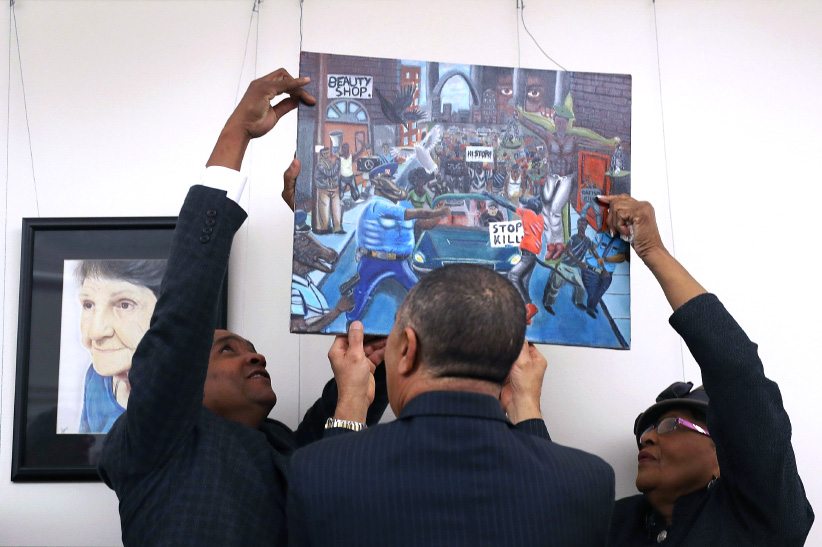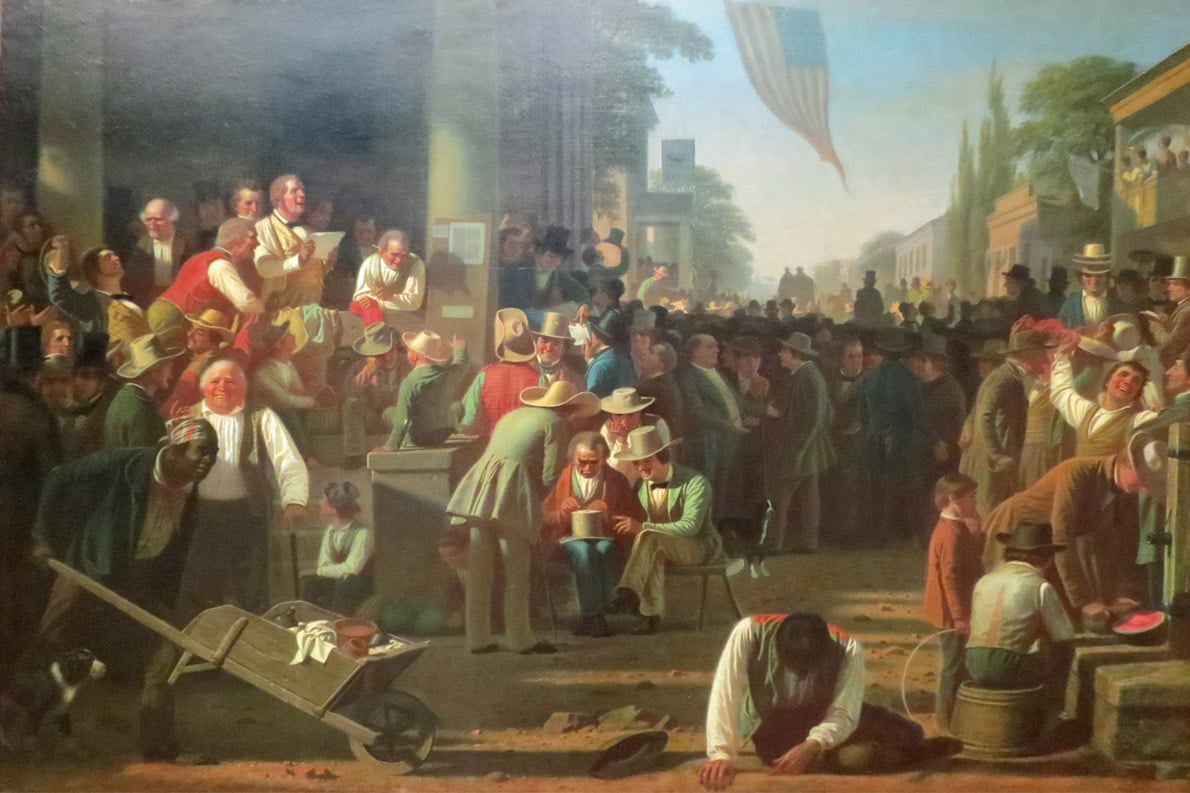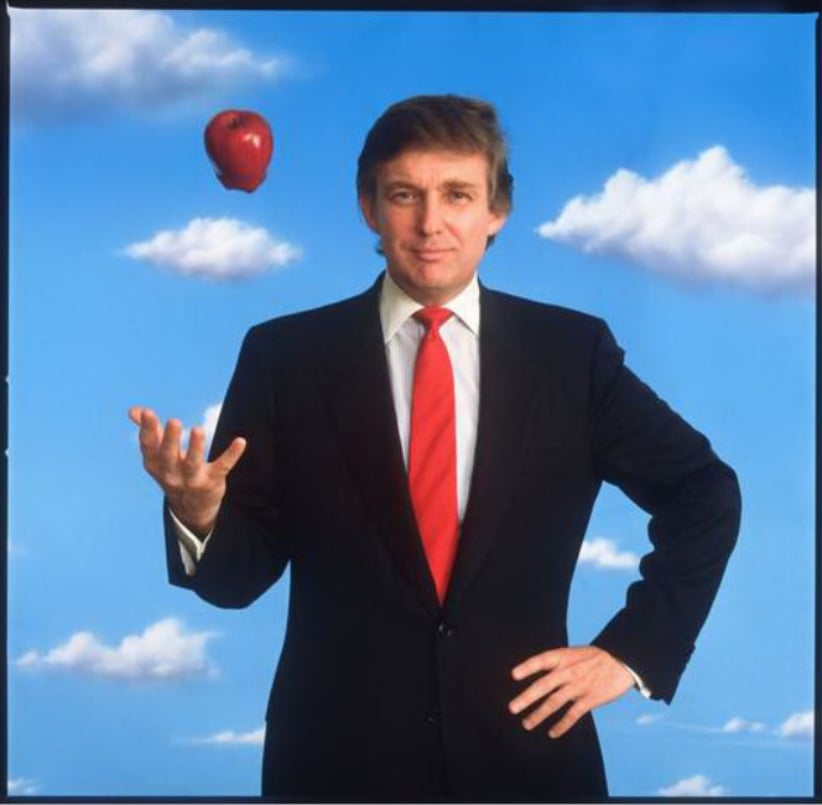Three works of art that define a divided America ahead of Trump
As Trump prepares to take office, an examination of the nation he is being asked to heal as told through two paintings and a photograph
Rep. Cedric Richmond, chairman Congressional Black Caucus, Rep. William Lacy Clay and Rep. Alma Adams rehang a painting on the U.S. Capitol walls after it was removed by Rep. Duncan Hunterbecause he found it offensive on January 10, 2017 in Washington, DC. (Joe Raedle/Getty Images)
Share

Three works of art from the 19th, 20th and 21st centuries—two paintings and a photograph—define the bitterly divided American nation on the eve of Donald Trump’s inauguration. One is a portrait of the 45th president himself as a young, gay blade, circa 1989. Another is a scene that celebrates popular (i.e., white male) democracy in the Midwest in the 1850s. And the third—yanked from display in the U.S. Capitol last week, then defiantly re-hung, then removed for good last weekend when no one was looking—depicts the police officers of Ferguson, Mo., as racist, murderous pigs with handguns and tusks (see above).
Their stories, in reverse order:
Every year, each of the 435 members of the House of Representatives sponsors a competition for high-school students in his or her respective riding that is called “An Artistic Discovery.” The winners are awarded a trip to Washington to attend the installation of the selected canvases in a cavern deep beneath the famous dome.
Most of the works on display this year are tame and gentle—pelicans, koi fish, ram’s heads, grazing bison, inexpert but respectful portraits of Geronimo, Walt Whitman, Bernie Sanders. Many reflect a patriotic theme, such as the little girl waving a flag as she leans on her soldier-father’s shoulder called “Welcome Home,” and the skilfully rendered depiction of an aircraft carrier on the open ocean entitled “Guardian of America.”
Others are more courageous. In one painting in the North Carolina grouping, under the sponsorship of an African-American Congresswoman named Alma Adams, a young black girl holds a single yellow rose under a crumpled Confederate battle flag that has been covered in strips of yellow tape that carry words such as PEACE and LOVE and BEAUTY IN EVERY RACE.
Further along, there is a scene of two police officers—pink-nosed but not otherwise overtly porcine—hauling away a black man who has been playing checkers against a Caucasian opponent. Quoted in the background and dated “Birmingham, Alabama, 1930,” are the words: “It shall be unlawful for a negro and a white person to play together with each other in any game of cards, dominos, or checkers.”
The painting is called “The Rules” and its patron—not surprisingly—is Rep. John Lewis, the venerated civil-rights crusader who has been the object of Donald Trump’s most recent and repulsive Twitter-bombs.
In the Missouri section, among the studies of dusty shoes and the St. Louis railway station, is a blank space on the wall. This is where “Untitled #1” and its pig-cops and crucified black youth and marching protesters was available for viewing, without public controversy, for six months, until an arch-conservative website took up the cause of removing it and several Republican members of Congress rose to echo one colleague’s characterization of the work as a “slap in the face to the countless men and women who put their lives on the line everyday on behalf of our safety and freedom.”
Hearing this, a (white) Congressman named Duncan Hunter from California took the elevator to the Capitol basement, pulled the painting off the wall with his own hands, and delivered it back to the (black) Representative from Missouri who had sponsored it in the first place. That Democrat, Lacy Clay, reinstalled it, accusing the Republicans of “retroactive, vigilante censorship,” and this undignified tug of war continued until Tuesday morning, when a Maclean’s correspondent went searching for “Untitled #1” and found it gone, probably forever, having been deemed by the Architect of the Capitol to be in violation of a rule forbidding “subjects of contemporary political controversy or of a sensationalistic or gruesome nature.”
So that is artwork No. 1.
No. 2 is George Caleb Bingham’s “The Verdict of the People,” painted in 1855, which has been borrowed from the St. Louis Museum of Art for display at a formal luncheon in the Capitol’s elegant Statuary Hall on Friday afternoon, shortly after Trump makes his inaugural address in what is forecast to be a driving rainstorm. (The selection of the Bingham canvas was made before the November election.)

Part of a trilogy that shows villagers in pre-Civil War Missouri exercising their franchise and then either hailing or mourning the results, the hat-waving winners and kneeling-in-the-mud losers in the painting are forerunners of this year’s vehement pro- and anti-Trumpers.
Yet even this outwardly patriotic offering has run afoul of the self-appointed constables of political correctness. A pair of St. Louis art historians have called on the museum to cancel the loan because, in their words, “a withdrawal will challenge the normalcy of this presidency.”
“Art has a crucial role in public discourse,” the women continued, “and the absence of art does, too. Lending this artwork for this specific inauguration is not an ‘honor’ because it normalizes the hatred, sexual abuse, and disregard for the office expressed by the president-elect.”
On Tuesday morning, a reporter wandering through Statuary Hall encountered Rosa Parks, Brigham Young, Junipero Serra, Barry Goldwater, Chief Sequoia and the inventor of the ice machine (from Florida, of course), but not “The Verdict of the People.” Whether it will be visible on Friday, when Trump (presumably) will eschew his customary Kentucky Frie d Chicken for what the official menu describes as “Grilled Seven Hills Angus Beef with Dark Chocolate and Juniper Jus and Potato Gratin” and “Korbel Natural Special Inaugural Cuvée California Champagne,” or tossed into the Crypt alongside “Untitled #1,” remains to be seen.
The third work of art is Donald John Trump himself at age 43, dark-haired and smiling, photographed against a blue sky and puffy Simpsons clouds, tossing a Red Delicious apple into the air in homage to Magritte’s The Son of Man. He is not wearing a wedding ring, even though at the time of the snapshot he still was legally wedded to the former Ivana Zelníčková.

This is at the National Portrait Gallery of the Smithsonian Institution, where Trump is the first exhibit to the left of the entrance, preceding Fred Rogers, Halle Berry, Geraldo Rivera, Joseph Brant and Katherine Hepburn, not to mention the previous 43 presidents of the United States.
Directly across the corridor from the photograph of Donald Trump is the late Tupac Shakur in a blue bandana and hundredweights of bling, his shirt lifted, showing off the tattoos on his six-pack that said THUG LIFE and 50 NIGGAZ.
An explanatory card notes that the rapper was “repeatedly condemned for his explicit, violent, and at times misogynistic lyrics” and adds that “his eight-month incarceration for sexual assault coincided with his crossover success.” Donald Trump’s says that he won the presidency by “tapping into a deep vein of populist American sentiment.”
Now the dark-haired young man with the delicious apple was being asked to heal the country that had, in the course of its tortured history, produced Tupac Shakur and Ferguson, Mo.; John Lewis and Rosa Parks; Mister Rogers and “The Verdict of the People.”
On Tuesday, an 80-year-old woman we’ll call Sarah from New York City, a retired art instructor, was gazing at the photograph of Donald Trump.
“When you look at your next president, what do you see?” she was asked.
“Do you mean HIM?” Sarah replied. “Old tangerine face?”